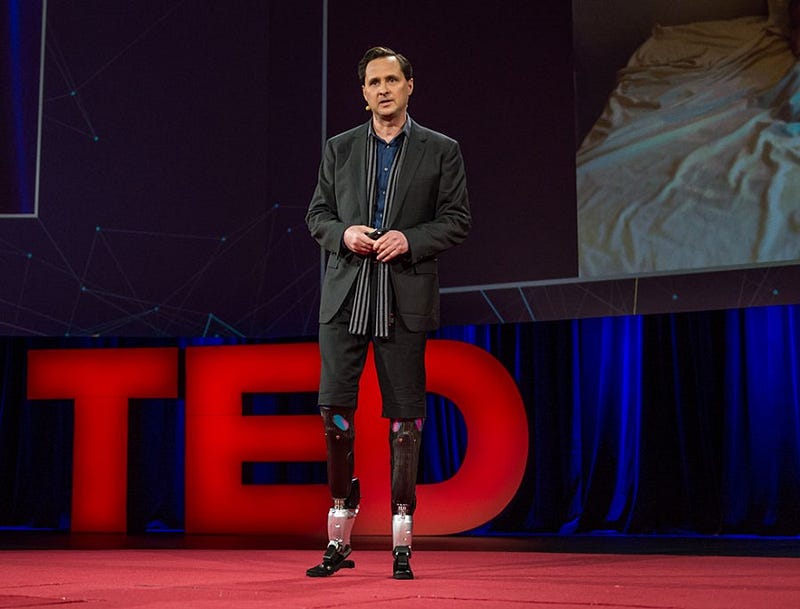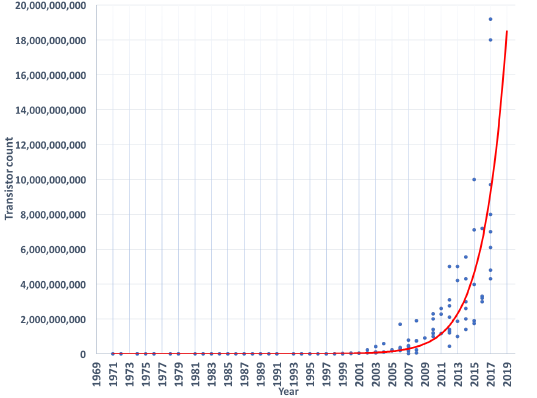The below picture was taken almost six years ago. In it, Hugh Herr, a leading biophysicist and professor at the MIT Media Lab, delivers a stunning speech about his research, personal triumphs, and the future.
Six years ago, the technology existed for that man — who lost his legs at age 19 in a freak climbing accident — to walk gracefully across the world stage, unperturbed by a condition that, just a few decades prior, would have rendered him wheelchair-bound and unable to even crawl up a flight of stairs.

Today, the artificial limbs Hugh that was working on in 2014 are even more advanced. Fueled by military and private sector funding, labs like the MIT Media Lab have made leaps and bounds in sensor technology, software, and hardware.
This exponential progression isn’t set to slow any time soon. We’re already at the point where bionic limbs are easily mistakable for organic limbs, but the next few years will see massive advances in battery capacity, computing power, and material durability. These advances will inevitably lead to the superiority of artificial limbs over biological limbs — and a whole host of ethical quandaries to boot.
Battery Power
Consider one of the current largest roadblocks to bionic limb superiority today — battery capacity.
Whereas organic limbs work twenty four hours per day, seven days per week, artificial legs like those developed by Hugh currently have battery capacities of only one to two hours. That’s long enough to walk across a stage and deliver an exhilarating speech, but not much in the realm of practical, day-to-day tasks.
To many, this seems like a difficult feat to overcome, rife with logistical issues and decades-long development. Battery life can only progress so quickly, after all.
Except… here’s a quick glance at energy density over the last century.

By 2030, assuming similar technological advances, battery power capacity will be several times that which Hugh Herr had to work with in the years leading up to 2014. This will lead to enormous improvements in battery life and product longevity.
Imagine a bionic leg with a battery life of fourteen to sixteen hours. You could equip your legs, put on a long pair of trousers, and leave for work — functionally indistinguishable from your colleague one cubicle over. At night, you’d take your legs off and set them on the bedside table for charging until morning.
By 2040, battery power capacity could be several dozen times stronger. These augmented limbs could be used for extended military trips, hard labor, and more.
Material Durability
Material durability is another roadblock to bionic limb superiority — current prosthetics are not strong enough to handle superhuman loads. To achieve the type of superiority we are discussing, future artificial limbs will need to be significantly more durable than organic bones and tissue.
Here’s a quick glance at advances in material durability over the last few centuries:

The vast majority of progress in this field has occurred in just the last few decades. We went from centuries of static iron and steel construction to complex composites and carbon fibers in a handful of years — and this trend parallels that which is found in nearly every other material-based industry.
Computing Power
How about increases in computing capacity or sensor technology? Admittedly, current bionic limbs can not yet fully replicate the fine sensations and subtle motor control that most organic limbs are capable of. The speed and granularity of these, however, are primarily dictated by improvements in transistor density.
Notice the similarity between this graph and the last two:

We have clearly been caught in the thrall of exponential growth in computing capacity. But the hardware isn’t the only thing to watch out for: increases in computing power inevitably lead to better software and more intelligent systems. These more intelligent systems will then make better decisions.
Soon, researchers and scientists will be able to leverage these better decisions to more effectively innovate and produce superior prosthetics. The next generation of prosthetic technology won’t just be manmade _— _it will be a byproduct of coopeeration between several classes of intelligent systems.
Suffice to say, there have been bigger objective improvements to the capability and quality of life of amputees in just the last ten yearsthen there have over the last ten thousand years. The next decade may very well see technological advances that are as incomprehensible to the modern man as iPads would be to neanderthals.
One day, perhaps very soon, we’ll stop seeing flashy TED talks on artificial limbs. When that happens, understand the following: this won’t occur because research and development progress will have plateaued, but because the technology will soon be so beyond our expectations that, if revealed, public sentiment would quickly shift from excitement to downright fear.
Exponential growth is a beautiful, dangerous concept. These new technologies will undoubtedly be used to produce better soldiers and more effective killing machines. They will also, however, be used to allow human beings to surpass their potential.
Athletes will be able to run and climb faster than before; dancers will move with a fluidity and grace never before seen; artists will create beautiful, otherworldly works of art; and ultimately, humans will build a better future for us and what comes after.






